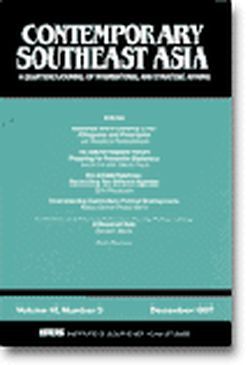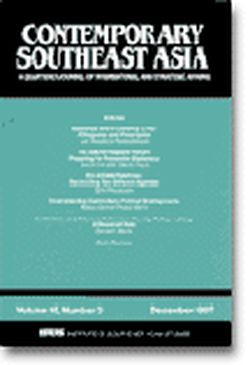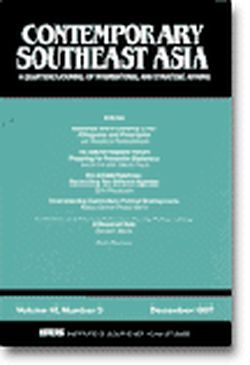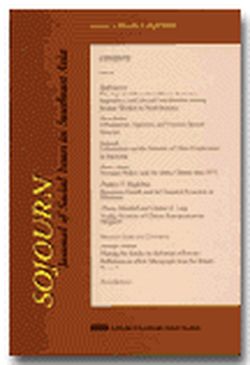Contemporary Southeast Asia: A Journal of International and Strategic Affairs Vol. 11/3 (Dec 1989)

Date of publication:
December 1989
Number of pages:
106
Code:
CS11/3
Contents
-
Preliminary pages
- ARTICLES
-
Problems in Australia's "Defence Revolution", by Thomas Durell Young, author see abstractThe Hawke Labour government has focused considerable domestic political attention on the issue of national defence. The government announced an ambitious defence programme that was well articulated in the 1987 Defence White Paper. One of the principal aims of current Australian defence policy is to effect a major shift in emphasis to the north of that country. A review of available facts, however, points to significant problems facing the realization of the government's objectives. First, it is clear that there are insufficient funds available for both the large capital acquisition programme and ongoing personnel/operational costs. This in itself has the potential for having long-term negative effects on the Australian Defence Force. Secondly, recent events show that the government apparently did not take into account the potentially serious security problems for Australia posed by instability in the island micro-states in the South Pacific, as well as the possible unreliability of New Zealand as an ally. In total, fundamental deficiencies can be identified as emerging in Australian defence. The evident result of these problems is that the U.S. security alliance will continue to be essential, if not increasingly so, to Australian security.
-
Thinking Independently about Strategy in Southeast Asia, by Theodore Olson, author see abstractIs it inevitable that Southeast Asian strategists should look at the strategic problems of their own nations and of the region and see what the superpowers see? The mutually-reinforcing concepts of ``region" and ``regime" con be employed to derive a more independent assessment of regional strengths and weaknesses and a more accurate picture of the ability of external powers to act effectively within the region, even on their own security perceptions. Particular attention is given to integration of the Indochinese states into the explicit security regime and to the problem of the naval ambitions of external states. Independent intro-regional assessment of policy proposals does not necessarily issue in a more independent security regime or policy for the region. But, unlike some current habits of thought, it does not suppress such a result.
-
A Survey of U.S. Post-Vietnam Policy and the Kampuchean Dilemma, 1975-89: A Southeast Asian View, by Pamela Sodhy, author see abstractThis article examines America's low-keyed role in the Kampuchean conflict against the backdrop of its bitter Vietnam War experience and its declining economic strength. The paper discusses the objectives, implementation, and effects of U.S. policy towards Kampuchea and its close link to U.S. policy towards Vietnam. The views of the Ford, Carter, Reagan, and Bush Administrations and their critics are included. Through the United Nations and ASEAN, America at first offered mainly humanitarian aid to Kampuchea. Later, it also extended overt and covert military assistance to the non-communist forces in the Coalition Government of Democratic Kampuchea (CGDK). Support for ASEAN's proposals to resolve the conflict has insulated America from the onus of deeper involvement and responsibility. Yet problems abound regarding the Khmer Rouge, Prince Sihanouk's leadership, and U.S. economic concerns versus security interests.
-
Japan and the Problem of Kampuchea, by Khong Kim Hoong, author see abstractOn its own, Kampuchea would not have been of importance to Japan, being neither economically nor strategically significant. Yet, given the international political alignment pattern in the late 1970s, it had to give some attention to the problem of Kampuchea. Japan's early relations with the Khmer Rouge regime become more complex as the Kampuchea-Vietnamese and Sino-Vietnamese conflicts escalated. With growing Soviet-Vietnamese relations and the invasion of Kampuchea, Japan leaned to the side of A SEAN and China. The Japanese tried to use aid as a lever on Vietnam, but to no avail. Japan's attempts to play a mediatory role between the conflicting parties have not been successful and neither have its proposals for peace and reconstruction in Indochina. Thus, for the time being, Japan is prepared to allow ASEAN to take the initiative.
- BOOK REVIEWS
-
BOOK REVIEW: ASEAN and the Security of South-East Asia by Michael Leifer, by Mike Yeong, author
-
BOOK REVIEW: Regime Change in the Philippines: The Legitimation of the Aquino Government edited by Mark Turner, by Steven Rood, author
-
BOOK REVIEW: New Directions in the South Pacific: A Message for Australia edited by Muriel Brookfield and R Gerald Ward, by Philip Methven, author






